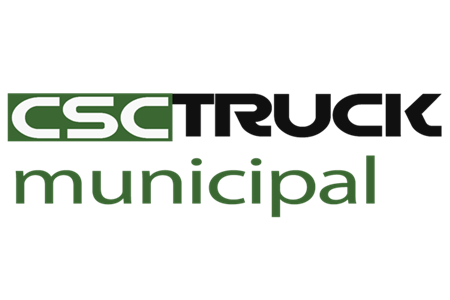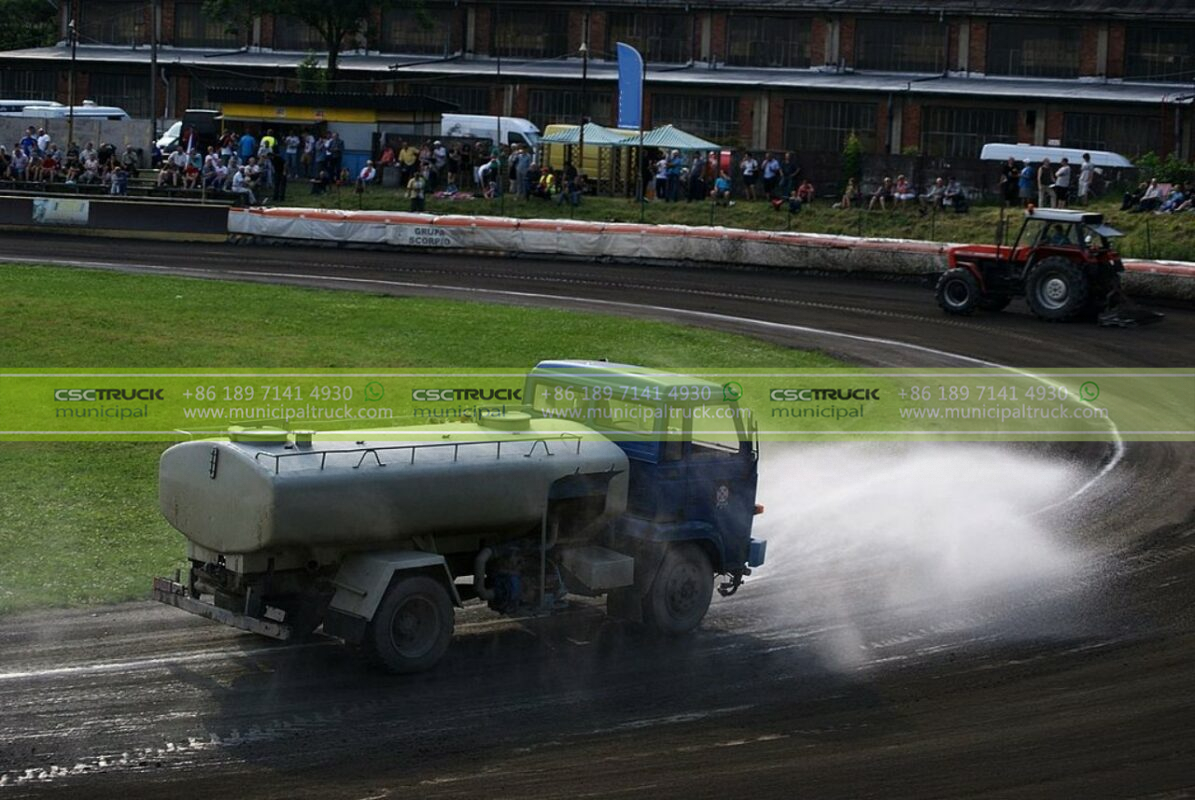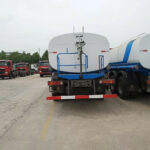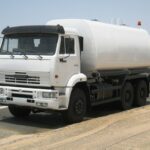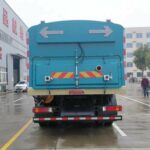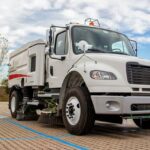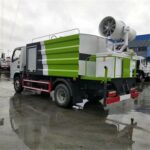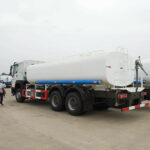In the heart of our bustling concrete landscapes, public parks stand as vital sanctuaries – essential lungs providing respite, recreation, and ecological balance. Yet, maintaining these verdant havens, particularly through the scorching heat of summer or prolonged dry spells, presents a monumental challenge for municipal managers. Traditional fixed irrigation systems often struggle with coverage inefficiencies, water waste, and the sheer scale of urban green spaces. Enter the often-overlooked hero of urban horticulture: the water sprinkler truck. Far more than simple mobile tanks, these specialized vehicles represent a sophisticated fusion of hydrology, engineering, and strategic planning, playing a pivotal role in revitalizing public parks by delivering precision hydration where and when it’s needed most. By combining mobility with targeted application, they ensure turf resilience, tree vitality, and floral brilliance, transforming the battle against urban heat islands and drought stress into a manageable, sustainable operation that keeps our communal oases thriving year-round.
Beyond the Hose: The Engineering Prowess of Modern Sprinkler Trucks
Dismissing these vehicles as merely “tanks on wheels” grossly underestimates their technological sophistication. Contemporary water sprinkler trucks are meticulously engineered systems designed for efficiency, reach, and minimal waste. At their core lies a high-capacity stainless steel tank, typically ranging from 2,000 to 6,000 gallons, constructed to resist corrosion from treated water and cleaning agents. This tank feeds a powerful, high-volume centrifugal pump, generating the substantial pressure necessary to propel water significant distances and operate multiple spray heads simultaneously. The true intelligence resides in the precision spray system mounted on the rear or sides. This isn’t a simple sprinkler; it’s an array of oscillating spray bars, cannon-style nozzles for long-range reach (often exceeding 100 feet), and sometimes boom extensions for targeting specific areas like median strips or hard-to-reach park edges.
Crucially, these systems incorporate adjustable flow controls and pattern selectors, allowing operators to tailor the water delivery precisely – from a fine mist for delicate flower beds to a heavier droplet pattern for deep turf penetration or dust suppression on park access roads. Pressure regulation valves ensure consistent performance regardless of tank fill level or pump demand. Modern variants increasingly feature integrated GPS mapping and flow metering systems, enabling operators to track exactly where and how much water has been applied, creating invaluable data logs for resource management and auditing purposes. This engineering ensures every gallon is utilized effectively, minimizing runoff and evaporation while maximizing root zone penetration.
Strategic Hydration: Optimizing Water Deployment for Park Vitality
The effectiveness of a sprinkler truck hinges not just on its hardware, but on the strategic deployment guided by horticultural science and resource management principles. This involves moving far beyond reactive watering to a proactive, data-informed approach:
- Hydro-Zoning & Plant Needs: Parks are complex mosaics of different plant types, each with unique water requirements. Mature trees demand deep, infrequent soaking to encourage robust root systems, while newly seeded turf needs lighter, more frequent applications. Sprinkler trucks enable zone-specific watering, allowing crews to apply the optimal volume and frequency to athletic fields, ornamental gardens, native grass meadows, and tree groves based on species, maturity, soil type, and sun exposure. This prevents the common pitfall of overwatering some areas while underwatering others, a frequent limitation of fixed irrigation.
- Targeted Response & Crisis Mitigation: Sprinkler trucks excel in rapid response scenarios. During unexpected heatwaves, they can be deployed immediately to critical areas showing signs of stress before permanent damage occurs. They are indispensable for establishing new plantings or sod where fixed irrigation isn’t yet installed or is insufficient. Following events like park festivals or sports tournaments that compact soil and dehydrate turf, targeted truck irrigation provides essential recovery hydration to restore damaged areas much faster than relying solely on rain or static systems.
- Complementing Fixed Infrastructure: Fixed irrigation remains vital, but sprinkler trucks are not competitors; they are powerful complements. They fill critical gaps in coverage, especially in older parks with outdated or incomplete sprinkler grids. They provide essential backup during system repairs or malfunctions. Furthermore, they allow for deep root watering cycles for trees – something many shallow-root-focused fixed systems cannot achieve effectively – promoting drought resilience and overall tree health that anchors the park ecosystem.
The Tangible Benefits: Greener Parks, Healthier Communities, Reduced Costs
Investing in a well-managed sprinkler truck fleet yields substantial, measurable returns for municipalities and park users alike, encompassing environmental, social, and economic spheres:
- Enhanced Turf & Plant Health: Consistent, appropriate hydration is the cornerstone of plant vitality. Sprinkler trucks enable the maintenance of lush, resilient turf capable of withstanding heavy foot traffic on sports fields and picnic areas. Healthy turf reduces soil erosion, dust, and provides a cooler surface temperature. Trees, the backbone of park ecosystems, receive the deep watering essential for their longevity, stability, and ability to provide shade and air purification. Vibrant flower beds and shrubs maintain aesthetic appeal, boosting the park’s visual impact and biodiversity.
- Mitigation of Urban Heat Islands: Parks are critical buffers against the urban heat island effect, where built-up areas become significantly hotter than surrounding rural areas. Healthy, well-watered vegetation actively cools the air through evapotranspiration. Sprinkler trucks ensure this cooling function remains operational even during droughts, providing crucial thermal relief for park visitors and contributing to cooler microclimates in adjacent neighborhoods. A thriving park can be several degrees cooler than the surrounding streets.
- Water Conservation & Operational Efficiency: Counterintuitively, strategic mobile watering often leads to significant water savings compared to poorly maintained or inefficient fixed systems. By targeting specific areas based on actual need (using moisture sensors or visual inspection) and avoiding overspray onto pavements or during windy conditions, trucks minimize waste. Their mobility allows crews to focus resources precisely where they are needed most, eliminating the inefficiency of watering large zones uniformly regardless of condition. Reduced wear and tear on fixed irrigation infrastructure also lowers long-term maintenance costs.
- Community Wellbeing & Park Usability: A green, thriving park is an irresistible community magnet. It encourages physical activity, social interaction, relaxation, and connection with nature – all vital components of public health. Maintaining turf quality ensures sports fields are safe and playable. Healthy trees provide essential shade, making parks usable even on hot days. The visible care invested through regular maintenance, including watering, fosters a sense of civic pride and encourages responsible public use.
Integrating Sprinkler Trucks into Holistic Park Management Systems
Optimizing the impact of sprinkler trucks requires thoughtful integration within broader park operations and resource management frameworks:
- Scheduling & Logistics: Efficient deployment demands sophisticated scheduling based on evapotranspiration rates, weather forecasts, park event calendars, and soil moisture monitoring data. Coordinating truck routes with other maintenance activities (like mowing) is essential to avoid conflicts and compaction of wet soil. Water sourcing is crucial – utilizing non-potable water sources like treated wastewater or harvested stormwater where available and appropriate significantly enhances sustainability credentials.
- Operator Training & Expertise: Maximizing the truck’s capabilities requires skilled operators who understand both the vehicle’s mechanics and the principles of horticulture. Training should cover safe operation (especially on slopes and near pedestrians), nozzle selection, pattern adjustment, water conservation techniques, basic system troubleshooting, and accurate data logging via integrated systems. Empowering operators with knowledge transforms them from drivers into hydration specialists.
- Data Utilization & Adaptive Management: The flow meter and GPS data generated by modern trucks are goldmines for adaptive management. Analyzing this data helps identify areas of chronic overuse or underuse, tracks seasonal water demand patterns, validates the effectiveness of watering schedules, and provides auditable records for water resource reporting. This enables continuous refinement of practices for greater efficiency and park health outcomes.
The Environmental Stewardship: Balancing Green with Blue
In an era of increasing water scarcity and climate volatility, the role of sprinkler trucks embodies a commitment to responsible environmental stewardship. Their strategic deployment directly combats the degradation of urban green spaces caused by drought stress. By enabling the survival and vitality of trees and vegetation, they support urban biodiversity, carbon sequestration, and air quality improvement. Furthermore, the ability to precisely control application minimizes runoff pollution, preventing fertilizers or pesticides (if applied) from being washed into storm drains and local waterways. When integrated with recycled water programs, sprinkler trucks become even more powerful tools for sustainable urban water management, ensuring parks remain green without straining precious potable water supplies. They represent a practical, scalable solution for maintaining the ecological services parks provide in the face of environmental challenges.
The Future of Park Hydration: Technology, Synergy, and Sustainability
The evolution of park irrigation continues, driven by technology and a deepening commitment to efficiency. Smart water management systems are becoming standard, integrating real-time soil moisture sensors placed strategically throughout parks. These sensors wirelessly transmit data to central systems or directly to truck operators’ tablets, enabling truly on-demand watering based on actual soil conditions rather than fixed schedules. Automated boom controls guided by GPS are emerging, ensuring perfect overlap and eliminating gaps or overspray. Research into subsurface drip systems deployed from trucks for specific high-value areas like tree alleys offers potential for even greater efficiency. Crucially, the future lies in integrated fleet management. While the sprinkler truck focuses on hydration, the sweeper truck maintains park hardscapes and pathways, removing debris that can harbor pests or detract from aesthetics. The compactor truck efficiently manages the waste generated by park visitors, keeping bins from overflowing and maintaining cleanliness. Together, these specialized vehicles – the sprinkler truck nurturing the green, the sweeper truck maintaining the grey, and the compactor truck handling the waste – form a synergistic triad essential for the comprehensive care, revitalization, and enduring appeal of our indispensable urban parks. Their coordinated operation ensures these vital community assets remain vibrant, healthy, and welcoming oases for generations to come.
